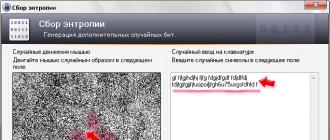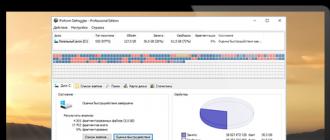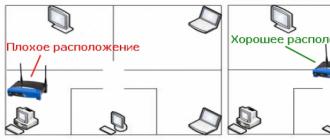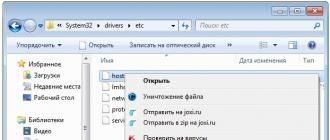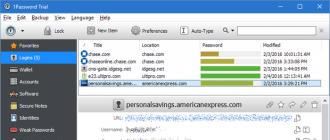How often do we think that it is already difficult to remember the passwords to all our accounts on various websites, portals and services? Many are saved by the password keepers provided for in the browser. Someone in the old manner records all passwords on paper or in a file. The most courageous use special programs for storing passwords. Bold because not all trust their information to programs, because nothing prevents them from passing passwords to their developers. And then goodbye postal address, account on the social network or access to the Internet. However, if at some point you do not trust your passwords to the program, you can simply forget them or lose them for some reason. We offer a small password storage utility called KeePass.
It remembers passwords and stores them in encrypted form. To access our passwords, we always need only one password - to enter the program.
Next, we will consider the Russified version of the program. To add a Russian interface to KeePass, download an additional file-crack. Unpack the archive and copy the file. Russian.lngx in the folder with the installed program. Then on the menu View - Change Language choose Russian. Then we restart the program and work with the Russian interface.
First of all, we create a new database where all passwords will be stored ( File - New). The program will ask us to enter the name of the database and specify the folder where it will be saved. It is best to specify a folder in which rarely one of the users of the computer comes in, which, most likely, will not be deleted. It would be nice if this folder was not on a disk with Windows installed (usually it is drive C), because when you reinstall the system, you can lose data on the disk.
Then you will need to enter the master password. As already mentioned, this password is needed to enter the program in order to restrict access to our data by other computer users. Enter the password twice in the appropriate fields.
Enable option Key file and press the button [New…]to create a key file. This is an additional measure that provides increased access security at KeePass. Here, the program automatically creates a file with keys, we are only required to move the cursor to a special area (in the left part of the window, like sprayed paint). Alternatively, you can enter random characters in the right side of the window. At the same time, we see how the bit rate is filled. It is desirable to bring it to 256 bits, which will mean maximum protection.

Then KeePass will ask a few more questions about the database, after which you can start working directly. In particular, you can configure the database encryption settings. All the above operations we will do only once when you first start the program. In the future, we will not need it.
At the end of the database creation, we see one entry in the list. This entry was created by the program as an example. When you select a row in the list at the bottom of the window displays detailed information about the selected password.
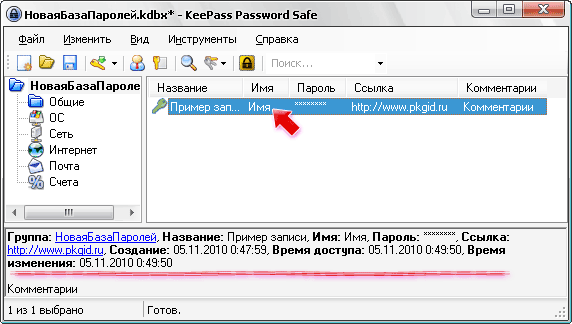
A double click on the password string causes KeePass to copy the password to the clipboard. True, the password will be stored in the buffer for 12 seconds (this time is easily adjustable), which is indicated by a decreasing time scale. After the specified time, the buffer is cleared. This is done again, to increase security, to reduce the chances of trojans or other spyware to intercept the password from the buffer.

To change the password settings, select it in the list and press the key Enter (or in the context menu select the item Edit / View Record ...). Here we can either change the password itself or reconfigure other parameters. This is a link to the site (for example, for which a password is specified), and a description of the link, name (login), comments. You can even assign a badge to the most important passwords to easily find them in the list.
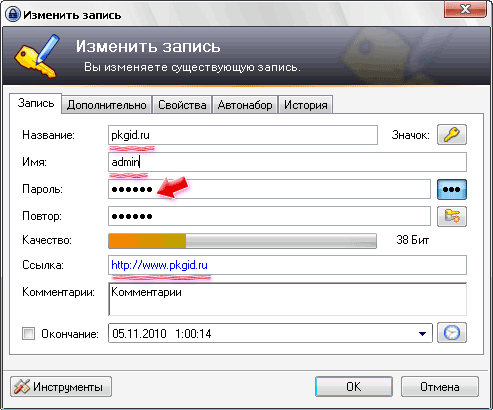
Another useful feature of KeePass is the generation of a strong password. To do this, next to the field where the password is entered, there is a button [Password Generation]. The password generator settings window opens where you can specify the length in characters and select the groups of characters that will appear in the password. It is advisable not to create a short password, and it should consist of a wide variety of characters (letters, numbers, characters). All settings can be saved to a profile and used later to generate passwords.
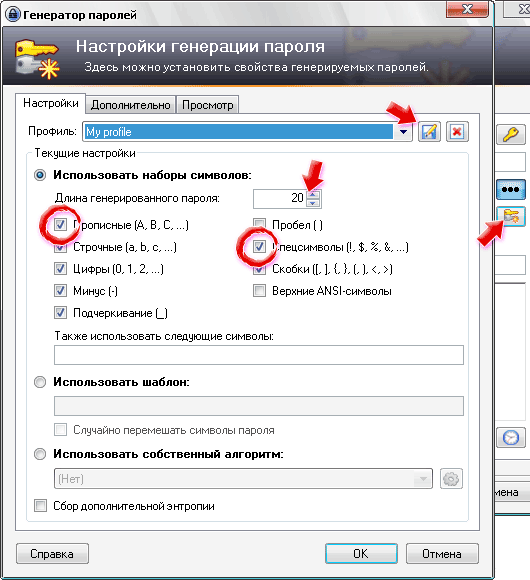
Here, for example, what password the program generated. Note that due to the use of a large number of different characters, the strength of the password has improved, it can be seen on the scale Quality. To view the characters of the password (remove the asterisks), click the button [Show / hide password behind asterisks]located next to the first password field.
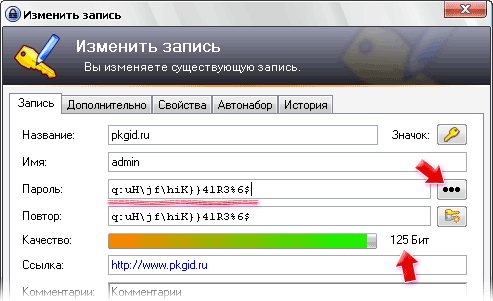
For convenience, the list provides several groups in which you can put passwords. The program offers us the following groups: General, OS, Network, Internet, Mail, Accounts.
KeePass allows you to both export the list of passwords to TXT, HTML, XML or CSV files, and also import data from files of the same formats. By the way, the list for import is much wider.
The program can also automatically enter a password in the form of authorization in programs or a browser. To do this, simply place the cursor on the first field (usually a login), go to KeePass, select a password and press the keys Ctrl + V . The program will do the rest for us: enter a login, enter the password field, enter it too, and then press the button [To come in].
Specifications:
Interface language: Russian, English and others
OS: Windows XP, Vista, 7
File size: 2 MB
License: free
Hello dear readers and blog visitors Spectr - rv .ru . Storing passwords in a browser is one of the easiest ways to save passwords, which does not require the installation of any additional programs. Today we will find out how you can use your browser to store and manage passwords.
Many of us spend much of our time on the Internet. At the same time, we often have to register on all sorts of forums and websites. Over time, the number of logins and passwords that must be kept in memory, begins to exceed all imaginable and unimaginable limits. Remember this amount of information is simply unrealistic.
In this case, you have to resort to the services of a program designed to memorize passwords, or, using the old-fashioned method, write down passwords in a special notebook. In short, each person finds a way out in the most appropriate way for him.
Consider the easiest and most accessible way to save passwords provided by the browser we use. This function provides for storing and storing in the browser the login, password and address of the site where we registered.
We will understand how the function of remembering passwords in the Mozilla Firefox browser works.
First of all, in the “Tools” menu, select the “Settings” item. In the “Settings” window that opens, go to the “Protection” tab (Fig. 1).
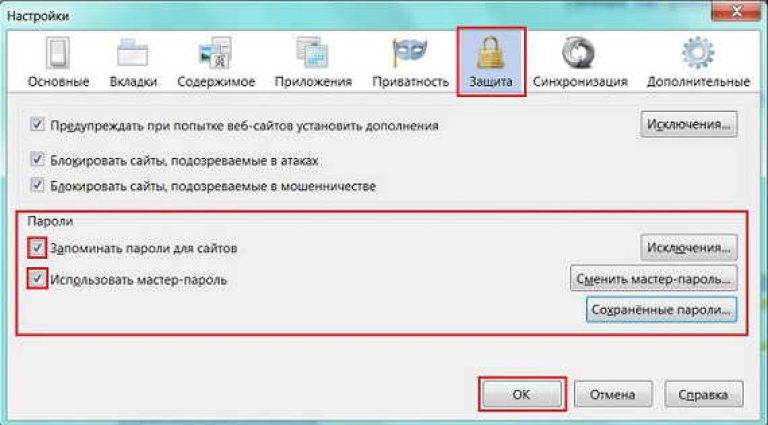
In the "Passwords" section, we check the presence of a tick in the " Remember passwords for sites"And, if it is absent, set. Click "OK". All - password memorization is enabled.
Now, when registering on any site, after entering the login and password, and clicking the "Login" button, a pop-up window appears with a picture of the key and a suggestion to remember the password (Fig. 2).

After clicking the " Remember password”, The login and password of the site will be saved in the browser.
The next time you log on to the site, the registration information for which is stored in the browser, the login and password fields will be filled in automatically. The user will only have to click the "Login" button and, thus, he will be spared the need to search and manually enter registration data.
Return to the section "Passwords". Here we see the button " Saved passwords”, By clicking which you can view the list of sites whose passwords are stored in the browser with the corresponding logins (Fig. 3) in the same window.
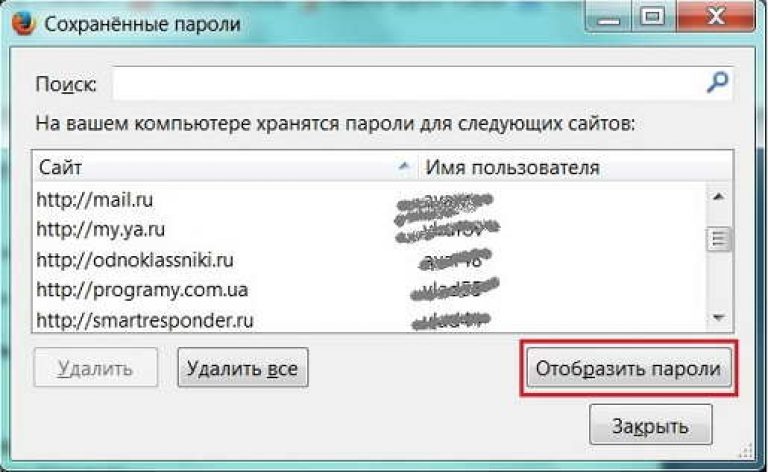
By clicking on any row in the list with the right mouse button, you can copy the login or password for the desired site. To remove any site from the list, select it and click the "Delete" button.
If you want to view the saved passwords themselves, you should click the " Display passwords". After confirming this need, in the window, besides logins, passwords for sites will be shown.
At the top of the window " Saved passwords»There is a search string designed to quickly find the registration data of the site at its address.
When you click the "Exceptions" button (see Figure 1, section "Passwords"), a window opens with a list of sites for which passwords will not be saved. This list includes sites that registered the button “ Never remember the password for this site."(See figure 2).
A master password can be used to protect saved passwords. To enable this feature, you need to tick the " Use master password"(See Figure 1, section" Passwords "). In the window that opens " Master Password Change»Enter your password twice and click“ OK ”. Remember or write master password.
The master password will have to be entered each time you launch Mozilla Firefox, as well as every time you try to view saved passwords (Fig. 4).

If you changed the password for a site, you need to remove the site from the list “ Saved passwords“And then, when entering this site, save the new password in the browser.
In other browsers, there is also a function to remember passwords, and although it may be organized somewhat differently, the meaning remains the same. If necessary, you can easily transfer saved passwords from one browser to another, for example from.
It should be borne in mind that storing passwords in a browser is not reliable enough. This method is convenient because it simplifies the procedure for entering the site, due to the automatic input of username and password. This method can be recommended for non-responsible sites and forums, and for use, for example, with payment systems, its use is undesirable.
To ensure the safety of passwords in case of browser failure, it is desirable to have a copy of the list of passwords stored in another location.
That's all that I wanted to tell on this topic. I hope the article was useful for you. Now you know that remembering passwords in the browser is a convenient and affordable way to store passwords and, perhaps, use this in practice. Until next time. Good luck!
Some took advantage of our advice and started using password managers, but some roughly scored and continue to write down all passwords in a notebook in the old manner, at best hiding a notebook with passwords in a locked cabinet with a key. In the worst case, a notebook (in an open, unencrypted form) on the desktop of the operating system.
Today I will introduce you to another method that, using special password cards, allows you to remember passwords, and to do this easily, without reading books about the development and improvement of memory and not engaging in brain upgrades.
The first step is to download a password card. You can download a password card for free and print it on the website. Or you can click on the link, wait until the pdf document opens and print directly in the browser by clicking the print button in the corner of the screen.
Every time someone downloads a password card, letters and numbers are randomly generated in it. For this reason, there can be no coincidence.
Print the card in duplicate. If one is lost, you can decrypt the password with a copy.
How to use a password card?
Now I will show you how to use this thing.
- We select and remember 1 letter and 1 digit. Let's choose F8.
- Now you need to enter in the fields with the right the name of the site / sites for which this password.
As can be seen in our example (in the screenshot), for the vkontakte site, which is recorded in line 1, starting with the letter F in the first row of the card, the password will contain 8 characters (we memorized F8) and the password will be “DGTCBUAc”
Remembering Passwords with a CardYou can choose any number of symbols and a letter for the starting point (make sure that they are easily remembered for you).
If you need to change the password on the sites, just print a new card and remember the new combination of 2 or 3 characters: letters and numbers,
Password Card: Conclusions
Below, I have gathered all the disadvantages and advantages of this password memorization technique. Before I go to conclusions make sure to smile. And then I noticed that you have been making a smart look for a few minutes and are not smiling;)
Humor in the public site www.saytAdvantages and disadvantages of a password card
Merits
- You need to remember only one number and letter.
- In this way, you can memorize a complex combination of characters ().
- Reliability and high security.
- Easy to use.
- There are no difficulties with changing passwords.
- No need to generate a complex password.
disadvantages
- You must have a password card with you.
I think the method described by me has every reason to be used in everyday life. If you like the article, share it with friends and don't forget to subscribe us on social networks. Good luck to everyone and safe use of the computer!
I have long thought about the question of how to remember the many passwords that have accumulated over 10 years of work at the computer, registering on the sites, as well as the keys to the programs, licenses and other important data for us.
Of course, you can simply record your passwords and keep them like this 🙂
Yes, so I kept my password database for about 3 years! 🙂 It's funny! To find the right password, it took me a fair amount of time, although I could use a search engine. 
This is terribly inconvenient, a little hurt and cut some password, it happened. Something was cut out, copied wrong and went-gone. Yes, and hack my base will not be difficult. Horror ...
And I can say with confidence: "I found the best solution!". For example, for me it is important that the program meets these requirements:- Included autoreserve password database.
- There was support for the password database on the phone, computer, and iPhone.
- Decent protection of the base itself from hacking.
- I really wanted to be with the Russian language.
- It was convenient to use these logins and passwords.
This is basic! Having rummaged in Yandex and Google, I found a lot of programs, such as: KeePass, Dashlane, LastPass and Kaspersky Password Manager.
I studied several programs: Last Pass, Dashlane, Kaspersky Manager and KeePass. Soul lay on the Keepass .. Well, let's consider it.
What can KeePass do and why?
The main objective of this program is to make life easier for us in terms of memorizing usernames and passwords. Indeed, since the advent of the Internet, it has become necessary to store important data for access to various resources: VKontakte, filebook, and so on ...
By the way, the number of sites has long exceeded one billion :).
And remember a large amount of data we can not afford. I can’t keep more than 3 good passwords in my head. And why keep in mind if it is possible to transfer all this to a convenient and practical use.
I foresee exclamations: “ After all, you can put the same passwords everywhere and not to bathe! ”
I will answer: It is possible, but firstly it is not very safe, if one of your passwords is recognized by someone, it all goes to hell. Well, let's say, no one learned.
Is it convenient for you to manually enter a long password each time? Or would you prefer automatic password entry!
Over time, more stringent requirements are introduced for passwords. For example, Facebook forbids the use of light passwords, for example: 123456 and others. 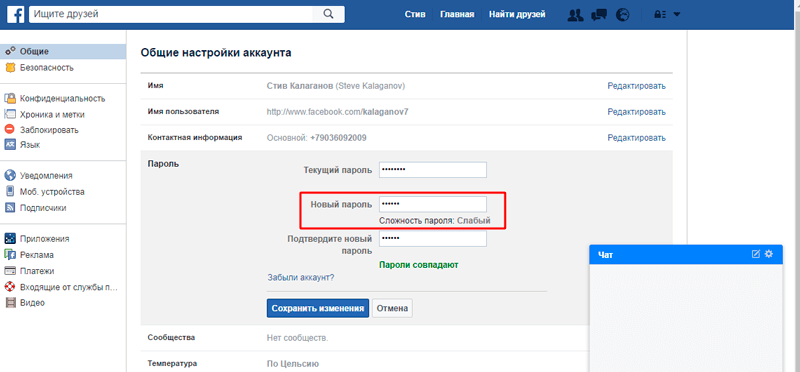 And sites that prohibit setting weak passwords are numerous. And this is all for our safety.
And sites that prohibit setting weak passwords are numerous. And this is all for our safety.
Current
Who are the Freelancers - Top 10: Infographics
Last example: Working in PJSC VimpelCom, each employee has his own account, under which he always works. And it is necessary to change the password every three months; (and of course this is all for the sake of our security.
Unfortunately, when a person buys a computer or laptop, then with him there is no teaching aid on how to use the purchase as efficiently as possible.
For this was created course from Evgeny Popov "Secrets of productive work at the computer".
As a result, the majority of users use their computer at the most primitive level, without using many tools that would allow to work faster, more conveniently and more productively.
It covers the most important points for productive work.
From the author: “For me, the efficiency of working at a computer directly affects my earnings, therefore, in recent years I have paid a lot of attention to this issue and formed my own system of highly productive work at a Windows-based computer.”
About KeePass
Full title: KeePass Password Safe - cross-platform free program for storing passwords, distributed under the GPL license. Program developed by Dominic Reichl, p the first versions of the program were for Windows. KeePass supports powerful Advanced Encryption Standard (AES (256-bit), Rijndael) and Twofish algorithms to encrypt the passwords of their databases. KeePass has a portable version of the program, which is not necessary to install. 
Official website of the program: http://keepass.info/
Pros:
- The program costs 0 rubles.
- Many plug-ins on the official site.
- There is a portable version, you can run on any computer.
- There are versions for Android (Keepass2Android), Mac OS (under a different name), and Windows OS and under Windows Phone
- High degree of protection
Minuses:
- Russian is not originally pre-installed, you need to download from the official site
The program exists since 2003 and to this day there are updates. At the time of this writing, the latest version of the program KeePass 2.34.
The program has many awards! The full list of awards can be viewed at: http://keepass.info/ratings.html
Full overview of the program interface
Overview of the start screen.

- Comment field: Required to write data, except logins, passwords, not always used. For example, there are sites where login and mail are different from each other. In the comment field, I enter the mailbox and phone number, as well as other important data for me. You can write anything.
- A field of all your passwords.Moving through the groups, you will be shown the records based on the group.
- Left sidebar - field of all your categories (groups) of records. Used for hierarchical separation of passwords into groups. For example, in a group of social networks passwords from a facebook, classmates and VKontakte, etc ...
- Search.Searches for all the text in each entry.
- The name of the password database.
- Functional buttons of the program. More about them below.
Current
Screen brightness not adjusted FN + ... Windows 10 or 8.1 (SOLVED)
Overview of the program function buttons
Review button "FILE"
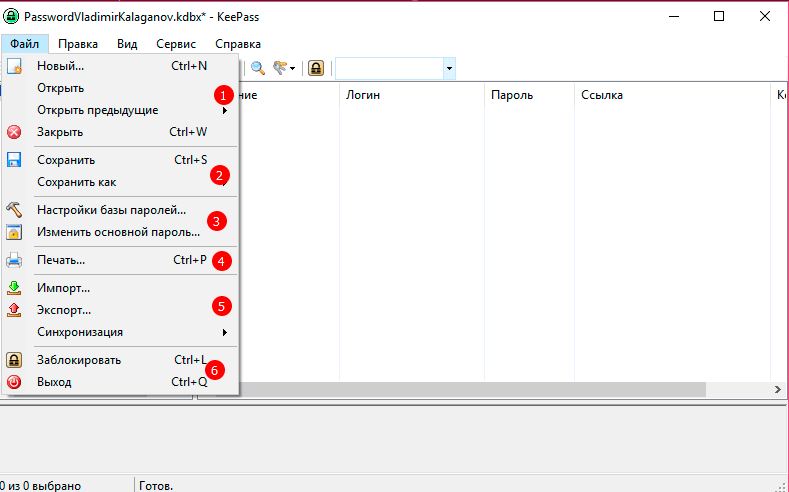
- New -the button is used to create a new password database.
- Open -to open the password database.
- An interesting button to open the previous -used to open previous password databases. He remembers the address of an open database and offers to open it.
- Button shut down- to close the current password database.
- Save -saves the password database, after any changes (Bastray CTRL + S).
- Save as -serves to save a copy of the database, save by reference (save the password database to the server or hosting).
- Password Database Setup -interesting section. Here you can configure the password database name, database description, change the background color, configure encryption level and so on.
- Change Master Password -here you can change the main password to any other. You can also add a key file to increase security.
- Print -with this button you can print the entire database. Logins, passwords, comments will be printed.
- Work with base import -used to add to the database from other password databases, export -saving for subsequent import to another program, password database or text view.
- Lock out- buttons are used to lock the password database or completely exit the database.
Review button "EDIT"
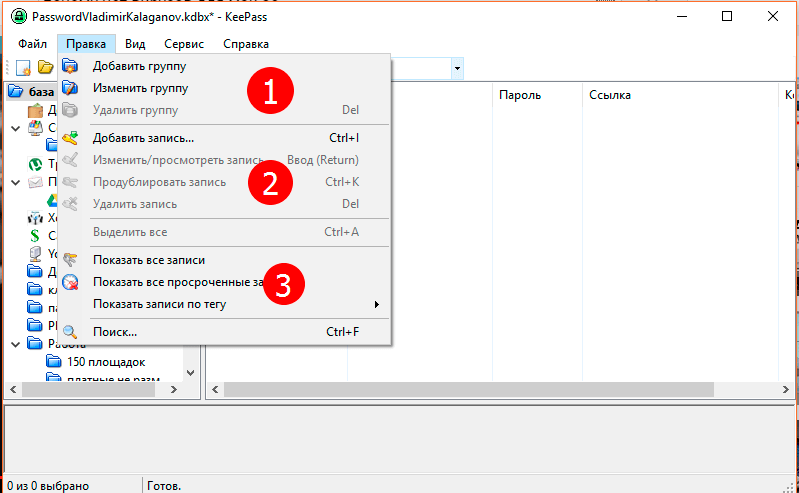
- Button serves for editing and creating groups (categories), for example: a group of social networks and in it records faybuk, VKontakte, etc.
- Required for creating records, i.e. account detailsth and work with them.
- Additional search functionality:
- Show all entries- lists all your notes in one row.
- Show all expired entries - in the event that you set a reminder to change the password and you did not change the password in time, this list will contain your entry.
- Show entries by tag - displays a list of main tags and allows you to conveniently navigate through them.
- Search (Quick button CTRL + F) -open the advanced search.
Overview of the "VIEW" button
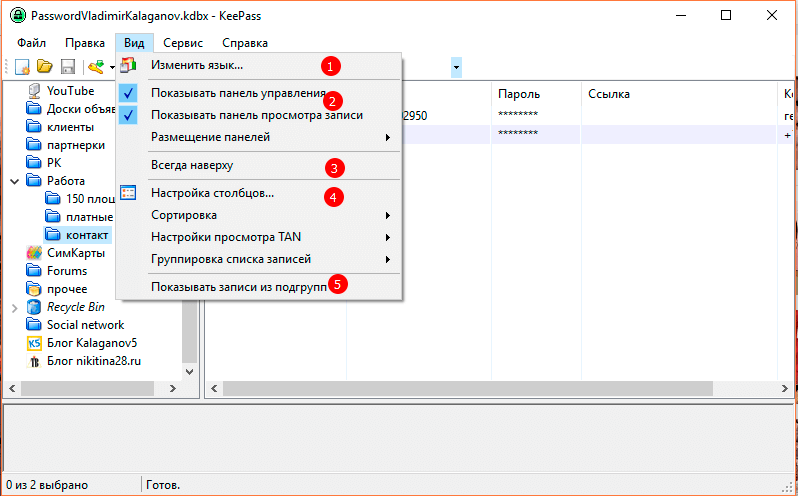
- Change the language -here you can change the language. You must first download it from official site and put in the root of the folder with the program.
- Buttons serve to adjust the location of the panels.
- Always upstairs -when this button is on, KeePass will always be on top of all windows.
- Here you can configure columns to display on the main window, for example: email field, attached files. You can also configure sorting: by name, by login, etc.
Current
How to put the program in startup for 7 seconds
Overview of the "SERVICE" button

- Password generator - here you can create a password using a generator and set various degrees of password complexity. The level of difficulty you choose.
- The program supports TAN codesi.e. passwords of a special type (only alphanumeric characters are allowed), which can be used only once. An entry in the TAN list is marked as expired when you use the “copy password” command of such an entry. These special passwords are used by some banks, where you need to confirm transactions with these TAN codes.
- BUT password database servicerequired for maintenance of the password database (deleting old records, removing duplication, cleaning garbage).
- Triggers and Modules- This is an additional expansion of the program. For example, database autosave, cloud sync plugins.
- Settings -where you can customize the program. For example: security, integration, appearance, and so on.
Setting up the program
Installing KeePass
- Download the program from the site: http://keepass.info/download.html
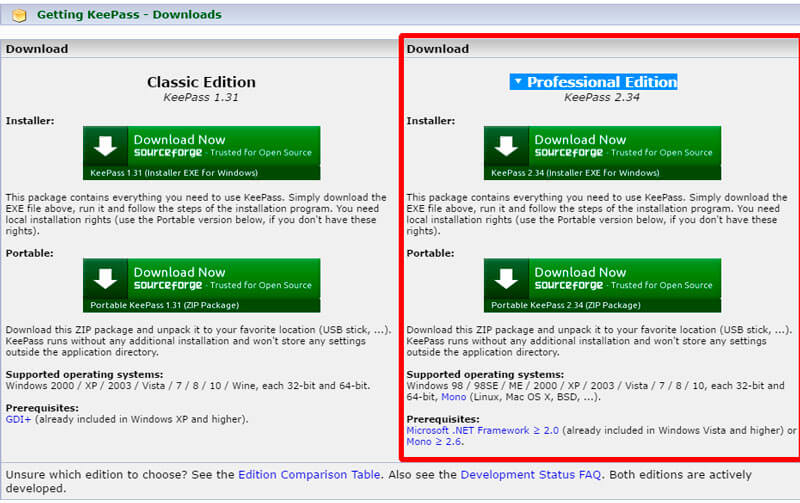
Better PRO version. If you ask: “Why is that?”, Then I will answer: “The menus and settings are more convenient and in the classics there are practically none. Therefore, we will use, respectively, the PRO version, the difference between the Installer and the portable.
- Run the downloaded file and follow the instructions. Installation of the program is standard.
Detailed video installation instructions
The master password must be complicated. After all, it will be your only password for all passwords!
Key file -can be used as desired. It gives a more powerful protection by the fact that you must always specify this file to open the database.
The downsides are that you always need to have this file on hand to open the database. I do not use this additional method of protection.
We put the program in autorun
To do this, go to the program settings: Service → Settings ↓
The second method is detailed: How to put the program in startup for 7 seconds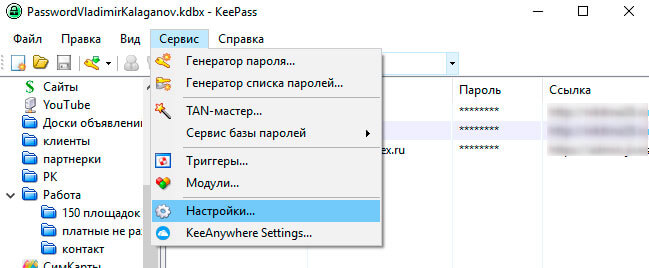 Further Integration →We put ☑ - Launch KeePass at system startup.
Further Integration →We put ☑ - Launch KeePass at system startup.Video "How to install the program in autoload"
Autosave after each base change
Autosave, like backing up, is an important thing! If suddenly we have a battery, and you did not have time to save the changes in the database, the data will be lost.
To configure, you must register the so-called triggers:
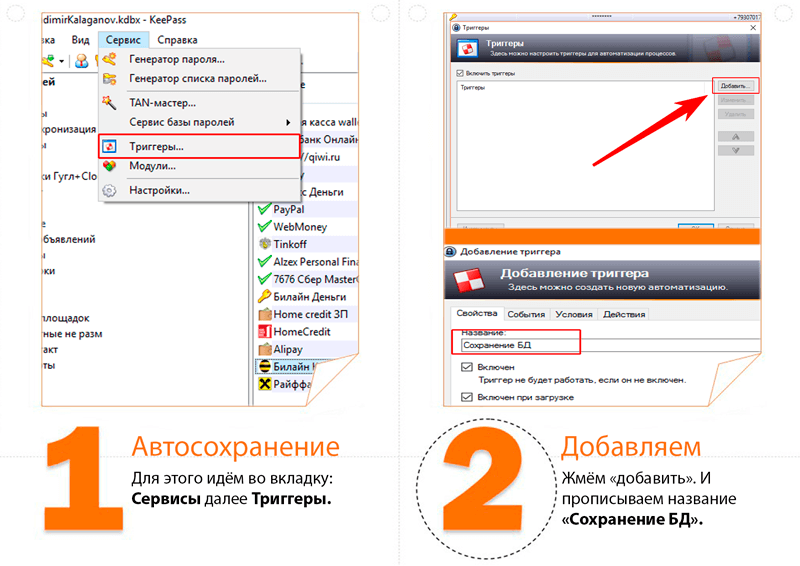

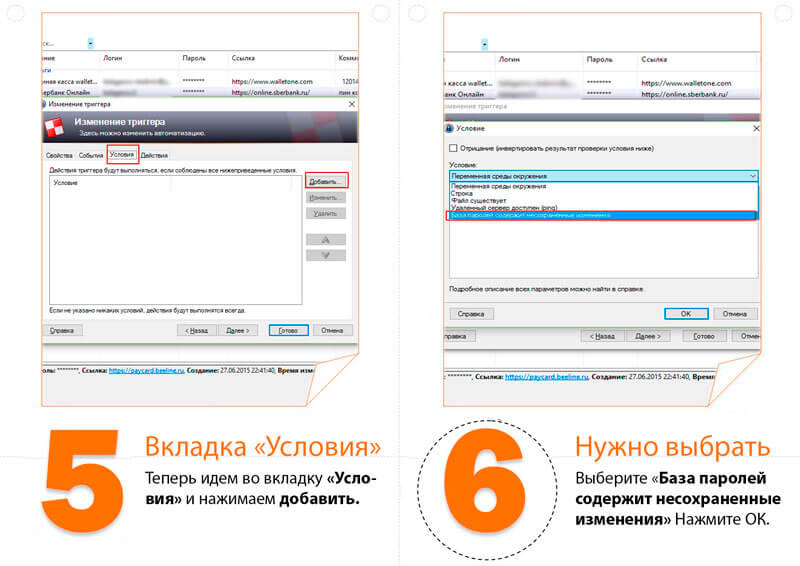
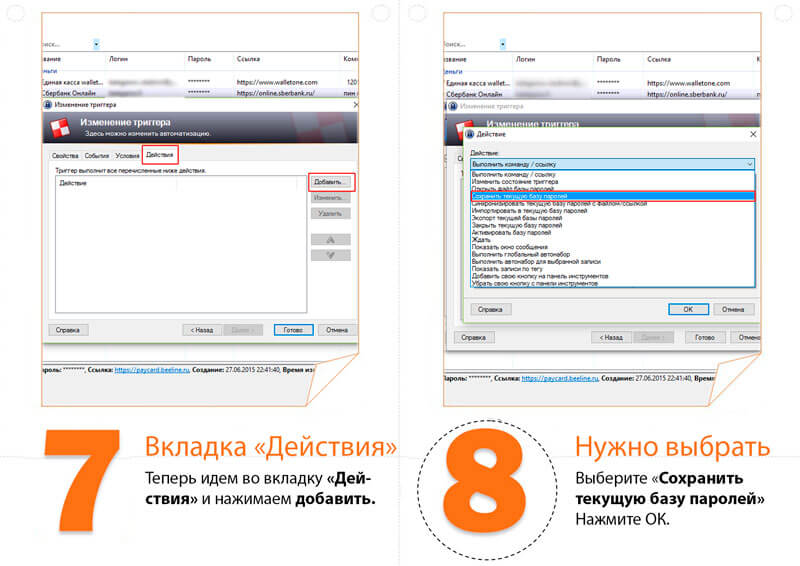
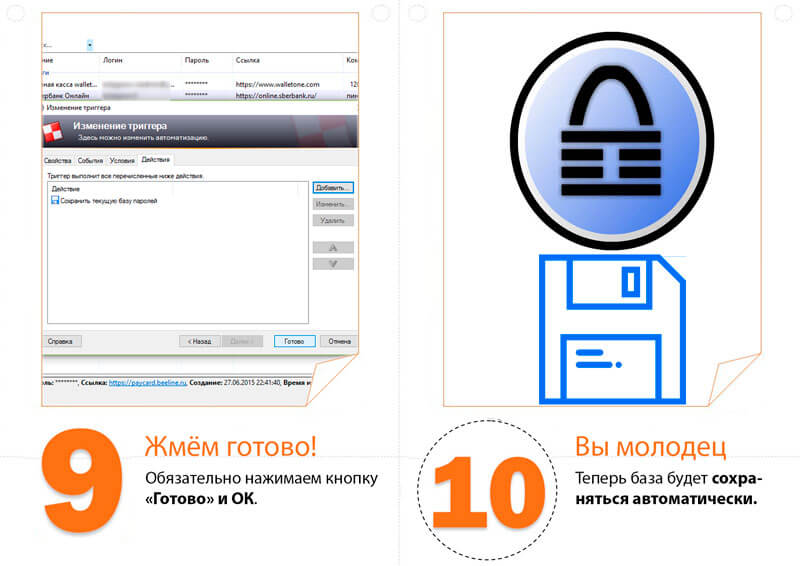
Now the base will be saved automatically.

